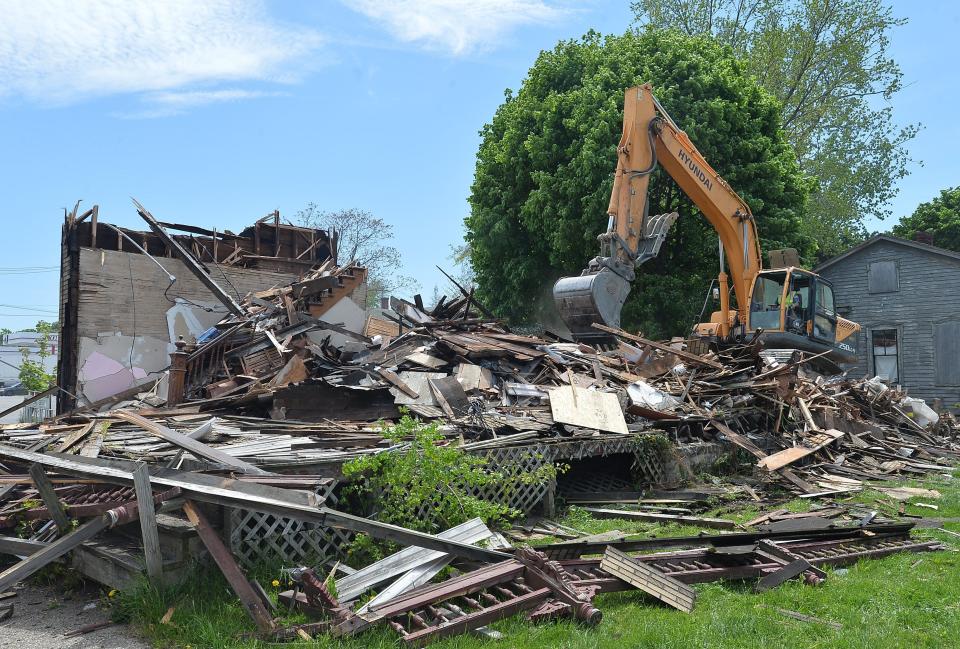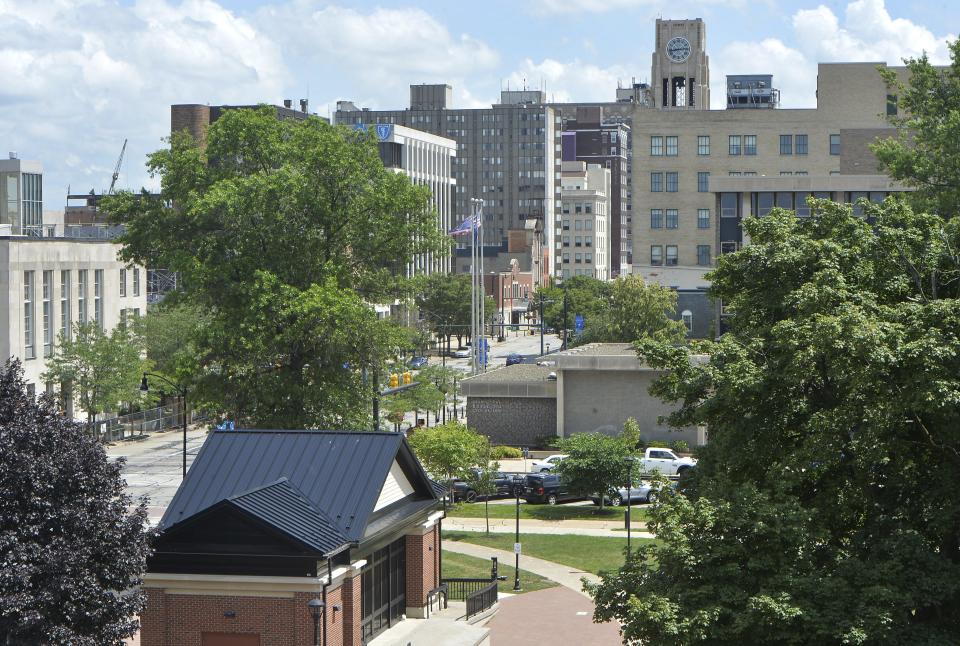How to resolve Erie's housing crisis? Register rentals, enforce code, fight blight
Erie's prospects for prosperity depend upon equitable housing. Neighborhoods with quality, affordable, mixed-income housing for all people create value that fosters upward mobility, attracts investment, and grows population. Therein is the problem and solution.
I'd like to introduce some recommendations for Erie's housing progress drawn from a Jefferson Educational Society report I recently authored.

The city’s housing woes are well-known. There are far too many dilapidated homes in struggling neighborhoods. Choice city blocks lack quality and affordability for both apartments and homes for owner occupancy. These conditions, facilitated by decades of disinvestment, cause a web of interrelated problems and lock the city in the grips of concentrated pockets of poverty, segregated neighborhoods, and intractable socioeconomic burdens.
Pandemic-fueled housing trends, together with rising inflation, make home ownership increasingly out of reach for many. All the while, renters too feel the pinch, as high demand contributes to landlords raising rental rates while too often not fixing up the units. Many Erieites rent. Many more are going to need to do so in step with the trend where Erie — the state's 5th largest city — is on its way to having more renters than homeowners. This is the case in Pennsylvania's 4th largest city — Reading, 3rd largest — Allentown, and 2nd — Pittsburgh. In the 1st largest, Philadelphia, rental units are 46% of total units. The growing number of rentals adds strain to the municipal and social systems at work to make neighborhoods attractive to investment, as is acknowledged in Erie's landlord and rental ordinance. It highlights the fact that rental units exact a greater incidence of problems than all other properties combined.
The mix of rental to ownership in the city of Erie is about even now and but varies greatly by neighborhood. According to 2021 American Community Survey data, of Erie's 44,856 housing units (total of all types), 48% (21,531 units) are rentals (up from 44% in 2000).

Erie's housing liabilities undercut otherwise monumental investments to buoy the economy. In order to thrive, all people need to have opportunity to reside together harmoniously across the city.
Benefits of mixed housing neighborhoods
Research substantiates that neighborhoods with mixed housing facilitate racial and economic diversity that lifts all boats. Youth under age 12 who move into mixed-income neighborhoods are more likely to attend college or university and less likely to be single parents than those who remain in unmixed poor neighborhoods. They make more money throughout life too. Furthermore, neighborhoods with diverse housing are not substantially lower income than exclusively single-family neighborhoods. And, allowing apartments, including subsidized housing, does not negatively affect property values, and even sometimes increases land values by capitalizing new development potential. Yet another benefit of mixed neighborhoods is enhanced tax and purchasing power necessary to support services and amenities like parks, retail stores, and markets.

Recommendations for strengthening Erie's systems for harmonious neighborhoods
Despite the benefits of mixed housing communities, neighborliness is not always a given. Desirous neighborhoods uphold shared values of: safety, cleanliness, respect, peace and quiet, and compliance with codes and ordinances. Such values are essential to neighborhoods being welcoming and embracing. Without them, those who can will move away. Investments languish. Blocks decline. Segregation and poverty rise.
As stated in Erie Refocused, "Restoring an ethic of reinvestment — of mutual reinvestment — is fundamental to the healthy functioning of markets but more so to the social contracts that make markets work, and that make cities strong." Accordingly, all cities have systems, policies, and programs that work to maintain neighborhood civility in the quest to attract investment — both by residents and in the form of new development. These include: code enforcement, rental registry, rental inspections, social/human services, pro-housing coordination, community initiatives, inclusionary zoning, fighting blight, data synchronization and coordinated response, police, and more.
More:Helping Erie's homeless will take multilayered plans as unsheltered population spikes
The good news is that Erie already has a good foundation of these programs and Erie's leadership is working hard on reforms to improve their effectiveness. The report summarized in this column presents many recommendations to mitigate Erie's housing disorder, a sampling of which are outlined below.
Code enforcement
Move from a reactive, complaint-driven code enforcement system to a proactive one. Perform a case study of similar cities to determine necessary staff capacity for a best-in-class program.
Strengthen the quality of life ticketing program and the disorderly/nuisance house ordinance.
As recommended by no less than seven studies dating back to 2008, Erie is overdue to implement a Housing Court devoted to cases involving substandard housing.
Rental registry
Devote sufficient resources to identify unregistered/unlicensed properties that are skirting the law.
Increase data collection. Following the example set by nearby Lawrence Park, Erie's rental registry should require: unit occupancy status; a listing of all Erie units owned, operated, or controlled by the landlord; and identification of a local manager, if the owner lives out of the county.
Make the rental registry database available to the public online. List the properties having the most code violations, late taxes, vacant properties, etc., both rental and non-rental as is Chicago's practice.
Rental inspections
Evaluate the pros and cons of discontinuing the city's current practice of outsourcing rental inspections to a third party. Consider increased efficiencies possible from handling rental inspections in-house together with property registry and in close coordination with city code enforcement.
Social/human services
Integrate social services with renters in need, following the lead of Erie's public housing providers. For example, Housing Authority of the City of Erie (HACE) caseworkers help families access social services, implement self-sufficiency plans, develop a budget, and set savings goals. As a result, HACE units are often better maintained and have better support programs for residents, compared to privately operated rental units. Erie's public housing leaders' attentiveness to residents is instructive of the need for enhanced coordination of supports among all renters (public and private), and many homeowners too.
Fight Blight
Increase allocation of American Rescue Plan funds to the Erie Land Bank to ensure rapid progress in transforming the city's some 6,600 vacant and abandoned housing units.
Data synchronization and coordinated response
Create a central database of property data (condition, log of public interventions across the range of service providers, ownership, etc.) that can be layered, integrated, and shared across departments. Configure the database to automatically track the severity and/or recurrence of incidents at a given property and alert responsible parties when a threshold is reached.
Police
Law enforcement is among the systems that strive to head off community decline. Given the high stakes of public safety, the dramatically changing role and environment of policing, and the heated public debate over the Erie Bureau of Police staffing level, the city should engage a nationally credible police consultancy for an independent analysis of its law enforcement system.
Annual Erie housing summit
Convene an annual housing summit to hasten changes necessary to facilitate mixed housing opportunities in every city neighborhood.
This is Erie's make or break moment
Mixed housing in diverse neighborhoods is reliant upon high-functioning civic systems that work together to ensure order and neighborliness. These systems lay the welcome mat and should be treated as drivers of development momentum. Fortunately, Erie has many capable parties working on housing issues. Every agency and organization, from landlords' professional associations to police to public housing and human service providers, are needed at the table to implement the recommendations above and more.
More:Community development playbook seeks to fuel $1.1 billion transformation in Erie region
Erie's greatest challenge is recognizing that unless all benefit, none benefit. The potential resulting from today's remarkable level of commercial investment around the city will not be realized until Erie's neighborhoods become choice habitable places for all. Housing is Erie's make or break hand needed to erase segregation and concentrated poverty and win in the competition to retain and attract residents. A growing population is needed to support the local economy and bestow an enabling tax base for best-in-class city services, which in turn create livable neighborhoods supportive of Erie's leading competitive advantage — its diverse people.
Court Gould, who lives in downtown Erie, is a sustainable solutions consultant. An expanded version of this article was first published by the Jefferson Educational Society on Aug. 29 and remains available free to download at JESErie.org.
This article originally appeared on Erie Times-News: Expert issues a call to action on blight, affordable housing in Erie

